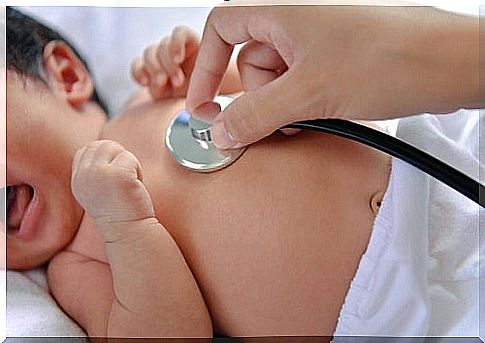Congenital Heart Disease: What Is It?

During pregnancy, the fetus may have congenital malformations or anomalies. Below, we will look at one of the most common in detail: you will find out what congenital heart disease is.
The types of abnormalities present in fetuses can be diverse, from hand malformations to heart problems. Thinking about this organ, a question spontaneously arises, the answer to which is very important: what is congenital heart disease ?
The word heart disease refers to any suffering of the heart and the cardiovascular system. On the other hand, the term “congenital” means “condition present from birth”.
Up to this moment, it is clear what we are referring to when we talk about this pathology. However, behind it lies a world of information relating to why it occurs in the fetus. We will tell you what are the types of congenital heart disease, symptoms and treatments.
Congenital heart disease
First, let’s define congenital heart disease as a birth defect. Because of this, the baby’s heart has problems in structure and functioning.
Let it be clear that, when we talk about congenital heart disease, we can actually include a large number of heart problems. It is true that, in fact, it puts the baby’s life at risk in its first year of life. But with proper medical care, this ailment can be overcome.
For the American Academy of Pediatrics, between 1% and 2% of children are born with congenital malformations. Meanwhile, according to the US Heart Association, 9 out of 1,000 newborns have congenital heart disease at birth. These medical data indicate that, in fact, heart disease can be considered as one of the most recurrent congenital defects.

The causes
Now we must ask ourselves why this occurs and what its causes are. As you know, the baby’s heart begins its development from the moment of conception. Its absolute development is completed by the eighth week of pregnancy.
It is during this period that the malformation occurs. The main cause is that not all the steps necessary to form a healthy heart have been completed.
Why this happens is a mystery. In the majority of cases where it occurs, there is no specific reason to be found and there is nothing the mother can do to prevent it.
“Congenital heart disease is a birth defect. Because of this, the baby’s heart has problems in its structure and functioning. “
Types of congenital heart disease
Types of congenital heart disease can be classified in several ways. In cardiology, we speak of cyanotic and non-cyanotic causes. Below, we will list each of the problems that the child may experience:
- Reduced blood flow to the lungs: When this happens, the baby’s blood is lacking in oxygen, and eventually, the same happens throughout the body. This leads the child to be cyanotic and have a bluish color on the skin.
- Excessive blood flow to the lungs: This causes the lungs to overwork and the baby’s blood pressure to rise.
- Little blood flow in the body: This happens when blood vessels are blocked and blood flow cannot flow properly.
Starting from these three main problems, cardiologists will specifically treat the malformations that produce them. Whether they are in the arterial ducts, in the interatrial communication, in the ventricular canals, in the pulmonary valves, among much more. In many cases, more than one heart disease or a combination of various categories may occur.

Treatment for heart disease
The pediatric cardiologists will deal with the treatment of each case of specific heart disease. Some of these anomalies may be detected even when the baby is still in the womb. While others may remain hidden for a certain period.
To treat these disorders, the specialist, together with a multidisciplinary team, will decide which will be the most effective treatment for the little one. The measures to be taken include the use of drugs alone up to corrective operations, based on each individual case and its severity.
A final aspect of the type of treatment is that, in case the child has to undergo an operation, the doctors will decide what is the most suitable time. On some occasions, corrective actions need to be done right away. In others, however, it is considered to wait months or even years before doing them.









